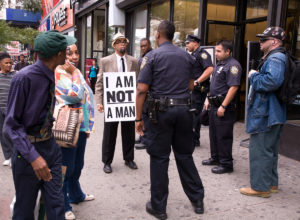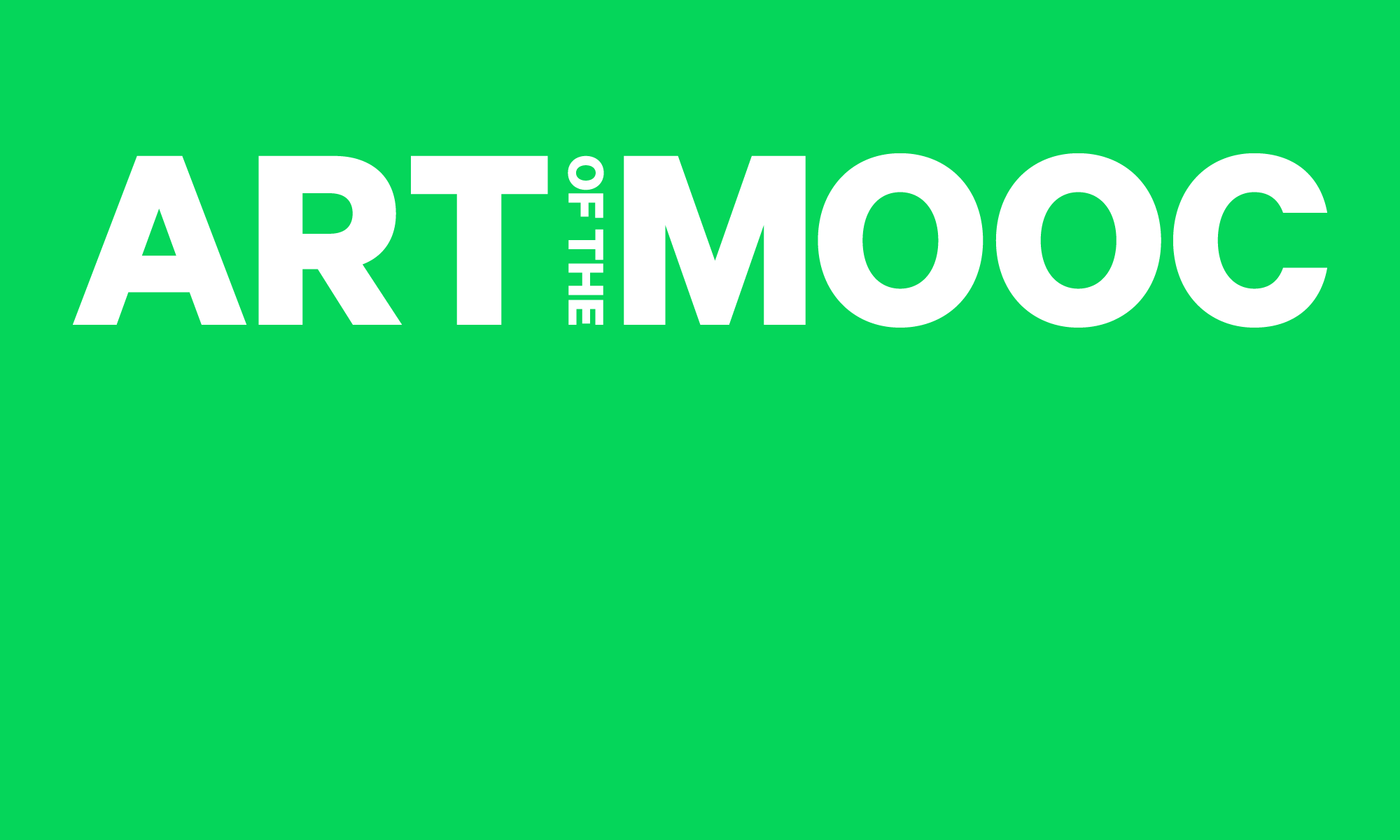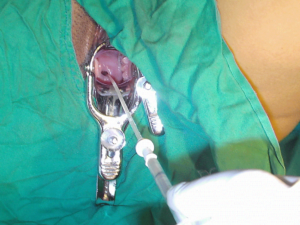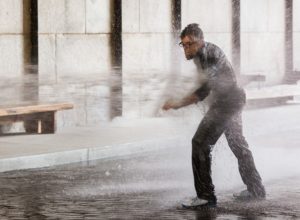“El Escandalo de lo real”
“El Escandalo de lo real” (2007) Susana Delahante
In this work Susana had a photograph taken of herself being inpregnated via a speculum with the semen of a recently deceased man. as explained in “Conducta” or behavior, better known as performance art. This performative artwork was concerning itself with engaging reality and ethics in a political domain. Law and ethics are what most heated discussions are made of, and also a good place for investigation. The artist carried the embryo for 1 month 2 weeks and 4 days which raised many ethical issues, and debates. How should we think of this? As an act of defiance? Or a very clever conceptual art practice that truly needed to be carried out?
That work was an experiment I made with the support of a Team. Here I submit my body in an artificial insemination, using spermatozos from an anonymous donor after his death and previously he was agree with this. By this test we got a real relation between two bodies, which in appearance are in different process and conditions. As a result we got a new organism. I was pregnant during 1month, 2 weeks and 4 days from February, 2007. So, is a fact we can not say: a body is absolutely dead when we know there are some part in it which still alive. (Susana Delahante)
Full EntryAu, Wayne. Critical Curriculum Studies: Education, Consciousness, and the Politics of Knowing.
(New York: Routledge, 2012). Print.
Full EntryBaum, Kelly et al. Nobody’s Property: Art, Land, Space, 2000-2010.
(Princeton, N.J.; New Haven: Princeton University Art Museum ; Distributed by Yale University Press, 2010). Print.
Full Entry
Beasley, Mark, and Royal College of Art. Democracy!: Socially Engaged Art Practice .
Royal College of Art Galleries 14 April – 12 May 2000 . MA Visual Arts Administration: Curating and Commissioning Contemporary Art. (London: Royal College of Art in association with the Arts Council of England, 2000). Print.
Full EntryBennett, Jane. Vibrant Matter: A Political Ecology of Things.
(Durham: Duke University Press, 2010). Print.
Full EntryBishop, Claire. Artificial Hells: Participatory Art and the Politics of Spectatorship.
Boyd, Andrew, and Dave Oswald Mitchell. Beautiful Trouble: A Toolbox for Revolution.
(New York: OR Books, 2012). Print.
Full EntryBradford, Gigi et al. The Politics of Culture: Policy Perspectives for Individuals, Institutions, and Communities.
(New York: New Press : Distributed by W.W. Norton, 2000) Print.
Full EntryBradley, Will, Charles Esche, and Afterall. Art and Social Change: A Critical Reader.
(London; New York: Tate Pub. : in association with Afterall ; Distributed in the United States and Canada by Harry N. Abrams, 2007). Print.
Full EntryCahan, Susan, and Zoya Kocur. Contemporary art and multicultural education.
(New York: New Museum of Contemporary Art : Routledge, 1996). Print.
Full EntryCerteau, Michel de, and Steven Rendall. The Practice of Everyday Life.
(Berkeley: University of California Press, 1984). Print
Full EntryCleveland, William, and Patricia Allen Shifferd. Between Grace and Fear: The Role of the Arts in a Time of Change.
(Champaign, Ill.: Common Ground Pub., 2010). Print
Full EntryCleveland, William. Art and Upheaval: Artists on the World’s Frontlines.
(Oakland, CA: New Village Press, 2008). Print.
Full EntryCleveland, William. Art in Other Places: Artists at Work in America’s Community and Social Institutions.
(Westport, Conn.: Praeger, 1992). Print
Full EntryCohen, Cynthia, Roberto Gutierrez Varea, and Polly Walker. Acting Together: Performance and the Creative Transformation of Conflict.
De Marchi, Neil, and Craufurd D. W Goodwin. Economic Engagements with Art.
(Durham, NC: Duke University Press, 1999). Print.
Full EntryDecter, Joshua, and Helmut Draxler. Exhibition as Social Intervention: “Culture in Action” 1993.
(London; [Annandale-on-Hudson, NY]: Afterall ; in association with the Center for Curatorial Studies, Bard College, 2014). Print.
Full EntryDewhurst, Marit. Social Justice Art: A Framework for Activist Art Pedagogy.
(Cambridge, Mass.: Harvard Education, 2014). Print.
Full EntryDoherty, Claire et al. Out of Time, out of Place: Public Art (now)
Dread Scott

I Am Not a Man; performance; 2009; duration 1 hour. Performance still 22 x 30 inches, pigment print.
“I Am Not a Man. I am but I am not. I Am Not a Man was a performance that was presented on the streets of Harlem, New York. I walked bearing a historic, but crucially altered, protest sign that read “I Am Not a Man.” Throughout the walk, actions in the performance evoked the humiliation that is visited on Black people and the negation that defines our existence.
Making reference to the 1968 Memphis Sanitation workers strike where the iconic “I Am a Man” sign originated, the performance inverted the sign’s statement, pointing to the importance of the Civil Rights protests as well as to their limitations. Along with this historic resonance, the performance simultaneously addressed our era—racism is foundational to America and has not abated. Despite assertions that America has entered a post-racial period, reality contradicts this: 1 in 9 young Black men are in prison; predatory lending policies have caused the greatest loss of wealth for people of color in modern U.S. history; Henry Louis Gates gets arrested “breaking into” his own home; etc.
I Am Not a Man resides in the uncomfortable space between a race-free fantasy world and the lived experience of millions.
The performance took place September 9, 2009.
I Am Not a Man is part of Rate of Change, a suite of street performances that I will be performing throughout New York in the coming months. Other works in the project include Kidney for Sale and Money to Burn. Announcements of the locations dates and times of these works will be available on the upcoming page.
This performance was made possible, in part, by the Franklin Furnace Fund supported by Stimulus funds from the New York State Council on the Arts, a state agency; the Lambent Foundation; and Jerome Foundation.
Dread Scott makes revolutionary art to propel history forward. He first received national attention in 1989 when his art became the center of controversy over its use of the American flag. President G. H.W. Bush declared his artwork What is the Proper Way to Display a U.S. Flag? “disgraceful” and the entire US Senate denounced this work and outlawed it when they passed legislation to “protect the flag.” To oppose this law and other efforts which would effectively make patriotism compulsory, he, along with three other protesters, burned flags on the steps of the US Capitol. This resulted in a Supreme Court case and a landmark First Amendment decision.
His art has been exhibited at the MoMA PS1, the Contemporary Art Museum Houston, The Walker Art Center and at the Pori Art Museum in Pori, Finlandas well as on view in America is Hard to See, the Whitney Museum’s inaugural exhibition in their new building. In 2012, BAM (Brooklyn Academy of Music) presented his performance Dread Scott: Decision as part of their 30th Anniversary Next Wave Festival. In 2008, the Museum of Contemporary African Diasporan Arts presented Dread Scott: Welcome to America. Winkleman Gallery and Cristin Tierney in New York have exhibited recent work and his public sculptures have been installed at Logan Square in Philadelphia and Franconia Sculpture Park in Minnesota. His work is in the collection of the Whitney Museum of American Art, the New Museum of Contemporary Art (NY) and the Akron Art Museum (OH).
He is a recipient of a Creative Capital Foundation grant, a Pollock Krasner Foundation grant, Fellowships from the New York Foundation for the Arts, and was a resident at Art Omi International Artists Residency and the Workspace Residency at the Lower Manhattan Cultural Council.
He has been written about in The New York Times, Art In America, Sculpture Magazine, ArtNews, ArtForum, Art21 Magazine, Time, The London Guardian and several other newspapers, magazines and books. He has appeared on numerous local and national TV and radio shows including Oprah, The Today Show, and CBS This Morning speaking about his work and the controversy surrounding it.
His work has been integrated into academic curricula and What is the Proper Way… is discussed in many art history classes and is featured in Henry Sayer’s “foundations” text A World of Art.
Dread works in a range of media including performance, photography, screen printing, video, installation and painting. His works can be hard-edged and poignant. He plays with fire—metaphorically and sometimes literally—as when he burned $171 on Wall Street and encouraged those with money to burn to add theirs to the pyre. The breadth of media he explores is unified by the themes he addresses and how he handles them. His art illuminates the misery that this society creates for so many and it often encourages the viewer to envision how the world could be.
Full EntryDuncombe, Stephen. Cultural Resistance Reader
(London; New York: Verso, 2002). Print.
Full EntryFeher, Michel. Nongovernmental Politics.
(New York; Cambridge, Mass.: Zone Books ; Distributed by MIT Press, 2007). Print.
Full EntryFinkelpearl, Tom. What We Made: Conversations on Art and Social Cooperation.
Finkelpearl, Tom. What We Made: Conversations on Art and Social Cooperation
Fleming, Ronald Lee. The Art of Placemaking: Interpreting Community through Public Art and Urban Design.
(N.p., 2007). Print.
Full EntryFlood, Catherine, Gavin Grindon, and Victoria and Albert Museum. Disobedient Objects.
N.P. 2007
Full EntryGell, Alfred. Art and Agency: An Anthropological Theory.
(Oxford; New York: Clarendon Press, 1998). Print.
Full EntryGoldbard, Arlene and Don Adams. New Creative Community: The Art of Cultural Development
Goldstein, Barbara and Americans for the Arts. Public Art by the Book
(Seattle: Americans for the Arts in Association With University of Washington Press, 2005). Print.
Full EntryHarper, Glenn, and Twylene Moyer. Artists Reclaim the Commons: New Works-New Territories-New Publics.
(Hamilton, NJ: ISC Press, 2003). Print.
Full EntryHelguera, Pablo. Education for Socially Engaged Art: A Materials and Techniques Handbook.
(New York: Jorge Pinto Books, 2011). Print.
Full EntryHickey, Amber, Angelina Köpplin, and Mary Tremonte. A Guidebook of Alternative Nows
(Los Angeles: Journal of Aesthetics and Protest Press, 2012). Web.
Book website with PDF link to text.
Full EntryIASKA Spaced: Art out of Place, A Recurring Event of Socially Engaged Art.
Jackson, Shannon. Social Works: Performing Art, Supporting Publics.
(New York: Routledge, 2011). Print.
Full EntryJones, Caroline A. “The Mediated Sensorium.”
in Sensorium: Embodied Experience, Technology, and Contemporary Art. (Cambridge, Mass.: MIT Press, 2006). Print.
Full EntryKlanten, Robert. Art & Agenda: Political Art and Activism
Ed. Matthias Hubner, et. al. (Berlin: Die Gestalten Verlag, 2011). Print.
Full EntryKnight, Cher Krause. Public Art: Theory, Practice, and Populism
(N.P. 2008). Print.
Full EntryKwon, Miwon. One Place After Another: Site-Specific Art and Locational Identity.
(Cambridge, Mass.: MIT Press, 2002). Print.
Full EntryLacy, Suzanne, Moira Roth, and Kerstin May. Leaving Art: Writings on Performance, Politics, and Publics, 1974-2007
(Durham, N.C.: Duke University Press, 2010). Print.
Full EntryLacy, Suzanne. Mapping the Terrain: New Genre Public Art.
(N.P. 1995). Print.
Full EntryMacPhee, Josh, Deborah Caplow and Eric Triantafillou. Paper Politics: Socially Engaged Printmaking Today
(Oakland, CA: PM Press, 2009). Print.
Full EntryMansfield, Elizabeth. Making Art History: A Changing Discipline and Its Institutions
(New York; London: Routledge, 2007). Print.
Full EntryMarsh, Anne and Jane Kent. Live Art: Australia and America: Performance Art, Reviews, Criticism, Feminist and Political Art Organizations, Art and Politics, Interviews with American Artists, Artist’s Pages.
(Adelaide, S. Australia: A. Marsh and J. Kent, 1984). Print.
Full EntryMichalski, Sergiusz. Public Monuments: Art in Political Bondage, 1870-1997.
(London: Reaktion Books, 1998). Print.
Full EntryMouffe, Chantal. “Artistic Activism & Agonistic Places.”
<i>Art and Research, A Journal of Ideas, Contexts and Methods</i> (20 Oct, 2015).
Full EntryPlatt, Susan Noyes. Art and Politics Now: Cultural Activism in a Time of Crisis.
(New York, NY: Midmarch Arts Press, 2010). Print.
Full EntryRelyea, Lane. Your Everyday Art World.
(Cambridge, Mass.: MIT Press, 2013). Print.
Full EntrySan Jose Museum of Art. Compassion and Protest: Recent Social and Political Art from the Eli Broad Family Foundation Collection.
(New York: Cross River Press, 1991). Print.
Full EntrySenie, Harriet and Sally Webster. Critical Issues in Public Art: Content, Context and Controversy.
(New York: Icon Editions, 1992). Print.
Full EntryShaughnessy, Nicola. Applying Performance: Live Art, Socially Engaged Theatre and Affective Practice.
(New York: Palgrave Macmillan, 2015). Print.
Full EntrySholette, Greg. Dark Matter: Art and Politics in the Age of Enterprise Culture.
Siraganian, Lisa. Modernism’s Other Work: The Art Object’s Political Life.
(New York: Oxford University Press, 2011). Print.
Full EntrySommer, Doris. The Work of Art in the World: Civic Agency and Public Humanities.
(Durham, NC: Duke University Press, 2013). Print.
Full EntryStarhawk. The Empowerment Manual: A Guide for Collaborative Politics.
(Vancouver, British Columbia: New Society Publishers, 2011). Print.
Full EntryStimson, Blake and Greg Sholette. Collectivism After Modernism: the Art of Social Imagination After 1945.
(Minneapolis, MN: University of Minnesota Press, 2007). Print.
Full EntryVon Blum, Paul. The Critical Vision: A History of Social and Political Art in the U.S.
(Boston, MA: South End Press, 1982). Print.
Full EntryWallach, John R. The Platonic Political Art: a Study of Critical Reason and Democracy.
(University Park, PA: Pennsylvania State University Press, 2011). Print.
Full EntryWaxman, Lori, Claire Pentecost, and Carrie Lambert-Beatty. Talking With Your Mouth Full: New Language for Socially Engaged Art.
ed. Elizabeth Chodos. (Chicago, IL: The Green Lantern Press, 2008). Print.
Full Entry

